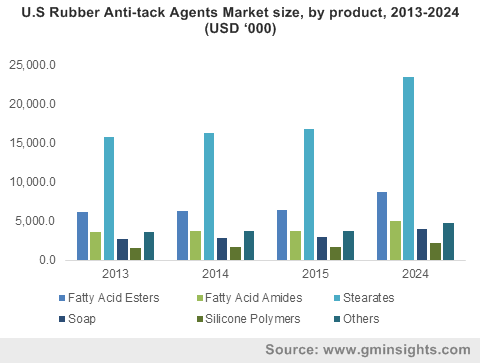Asia Pacific Rubber Anti-Tack Agents Market to contribute substantially toward global revenue, massive expansion of the automotive sector to propel the regional growth over 2016-2024
Publisher : Fractovia | Published Date : 2017-04-25Request Sample
Anti-tack agents are massively used for rubber tire processing & manufacturing, in response to which Global Rubber Anti-Tack Agents Market is expected to exhibit profitable growth potential. Rubber is a chief raw material that is used to manufacture products to be used across the medical and industrial sectors. For instance, rubber nitrile gloves that help prevent the transmission of bacteria are widely used in the automotive and healthcare sectors. Characteristics such as abrasion resistance, strong grip, low rolling resistance, impermeability, and oil resistance have led to the widespread usage of diverse types of rubber (nitrile rubber (NBR) and styrene-butadiene rubber (SBR)) in tire manufacturing. The rapid growth of the automotive industry has led to the development of the tire industry, which in turn, will lead to rubber anti-tack agents market expansion over 2016-2024.
Leading giants of rubber anti-tack agents industry accounted for approximately 40% of the global share in 2015. This market is fairly consolidated and fiercely competitive. Owing to high initial capital investment, industry players across the Asia Pacific and North America intensely compete with one another in a bid to expand their regional presence. Novel product developments coupled with technological innovations are key strategies adopted by these players to outwit one other. In addition, they are known to liaison with local raw material manufacturers for the purpose of developing cost-effective products, especially across regions such as APAC.
U.S Rubber Anti-tack Agents Market size, by product, 2013-2024 (USD ‘000)

Asia Pacific dominated rubber anti-tack agents market in 2015 with a contribution of more than 50% to the global revenue. China, India, Indonesia, and Malaysia are touted to be the key regional contributors toward APAC industry growth. In fact, the world’s top 6 rubber manufacturers belong to the APAC zone – Thailand is currently the world’s largest rubber producer, followed by Indonesia, Vietnam, China, India, and Malaysia.
Driven by the robust growth of the automotive sector in the region, Asia Pacific rubber anti-tack agents market is expected to grow at a rate of 4.5% over 2016-2024.
Increasing awareness regarding hygiene pertaining to the prevention of bacteria and virus transmissions will drive North America rubber anti-tack agents industry, which was worth more than USD 40 million in 2015. Primarily driven by U.S. rubber anti-tack agents market, this regional industry will depict significant growth over 2016-2024. The presence of a vast number of hospitals and nursing homes in the region coupled with increasing healthcare expenditure will augment U.S. rubber anti-tack agents industry.
Fatty acid amides, soaps, stearates, fatty acid esters, and silicone polymers are key products that comprise global rubber anti-tack agents market.
Soap products are used as anti-tack agents in rubber compounds for processing uncured polymers. This is done to primarily enhance the productivity and performance of rubber. Rubber anti-tack agents industry from soaps is anticipated to observe a CAGR of 4% over 2016-2024.
Stearates dominated the product landscape by holding more than 40% of global rubber anti-tack agents market in 2015. Specific stearates such as lead are classified under the list of products that can potentially harm the environment. Stringent regulations pertaining to environmental pollution may cause rubber anti-tack agents industry from stearates to witness a relatively moderate growth over 2016-2024.
Fatty acid esters such as glycerol monostearate find extensive applications in rubber processing, primarily driven by the environment friendly features provided by the product. Isoamyl laurate, one of the many natural fatty acid esters, is used to cure the adhesion property of uncured rubber. Subject to such a wide application spectrum, rubber anti-tack agents market from fatty acid esters is expected to grow substantially over 2016-2023, having held a revenue of USD 55 million in 2015.
The presence of huge production amenities for acid esters and fatty acids in North America and Asia Pacific will serve to increase the rivalry among major industry players. Key participants of rubber anti-tack agents market include FACI SPA, Lion Specialty Chemicals, Hallstar Company, McLube, Croda International, Stephenson Alkon Solutions, Schill + Seilacher, Peter Greven GmbH, Baerlocher, SASCO Chemical Group, King Industries, Evonik, and H.L. Blachford.